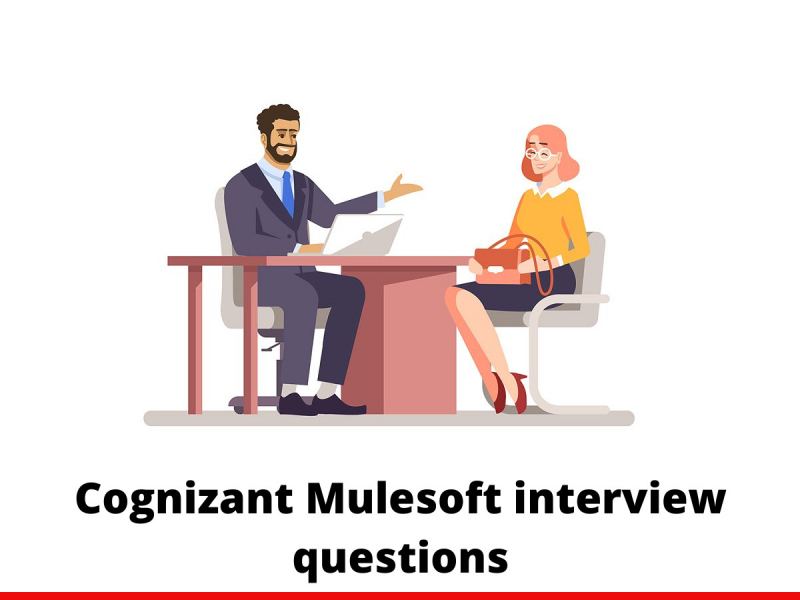Cognizant Interview Questions on Mulesoft
 Download Cognizant Mulesoft Interview Questions PDF
Download Cognizant Mulesoft Interview Questions PDFBelow are the list of Best Cognizant Mulesoft Interview Questions and Answers
The singleton pattern is the simplest design pattern that restricts the one instantiation of a class that involves only one object that is responsible to make sure there is no more than one instance. Class instantiates itself and at the same time. It provides a global point of access to that instance and ensures the same instance can be used from everywhere
You can declare a function in the header or body of a DataWeave script by using the fun keyword.
Declaration of a function in data weave is as follows:
fun function_Name(objParameter) = {
Variable1: objParameter.field1,
Variable2: objParameter.field2
} You can simply Invoke the function by using functionName() or functionName(arg1, arg2, argN).
In Java, serialization is a mechanism to persist java objects in a form of a sequence of bytes that includes the object’s data as well as information about the object’s type and its value. When there is a need to send your data object over a network or to store it in files you can use serialization. In other words, you can say that Serialization is the process for the conversion of an object code into a byte stream. Whereas, Deserialization is the reverse process of serialization, where the byte stream is used to recreate the actual Java object code in memory.
Middleware is software that acts as an intermediary between an operating system and software applications, especially on a network. Middleware is generally used for linking various software applications and passing data between them. Thus, It is also known as "software glue" and plumbing. For example, it can help an organization by messaging its customers, linking its payment and other systems with its customer-focused applications. Middleware enables communication and resource management for distributed applications.
MuleSoft considered that API-led connectivity is a methodical way to connect data to applications through reusable and purposeful Application programming interfaces generally known as APIs which are developed to play a specific role. APIs work for unlocking data from systems, composing data into processes, or delivering an experience.
Different types of flows in Mulesoft are listed as follows:
- Subflows
- Synchronous Flows
- Asynchronous Flows
Subflows are synchronous flow that inherits the processing and exception handling strategy from the parent flow.
Synchronous Flows are synchronous flow with their processing and exception handling strategy.
Asynchronous Flows are asynchronous flows with their processing and exception handling strategy.
Exceptions are the runtime error for a software. Error is a measure of the estimated difference between the observed or calculated value of a quantity and its true value.
In Messaging Exception, each exception strategy can contain any number of message processors.
Different Messaging Exception strategies available in Mulesoft is as follows:
- Catch Exception Strategy
- Choice Exception Strategy
- Default Exception Strategy
- Reference Exception Strategy
- Rollback Exception Strategy
We can use the Groovy component to throw exceptions manually.
In Mulesoft, TSD or transport service descriptor is a connector used for technical configuration. TSD defines class names used for message receivers, dispatchers, and requesters.
UMO is referred to as a Universal Message Object. Mule UMO is presently an inheritance term, which was once alluded to as UMO Components are presently alluded to as Service Components.
The term transient means for a moment. You can say that it lasts only for a short time. It is sometimes referred to as impermanent.
Also Read Related Cognizant Mulesoft Interview Questions | ||
|---|---|---|
| CodeIgniter Interview Questions | PHP 7 Interview Questions | |
| Azure Interview Questions | Spring Boot Interview Questions | |
| Apache Camel Interview Questions | ESB interview questions | |
Latest Interview Questions-
Silverlight Interview Questions
-
Entity framework interview questions
-
LINQ Interview Questions
-
MVC Interview Questions
-
ADO.Net Interview Questions
-
VB.Net Interview Questions
-
Microservices Interview Questions
-
Power Bi Interview Questions
-
Core Java Interview Questions
-
Kotlin Interview Questions
-
JavaScript Interview Questions
-
Java collections Interview Questions
-
Automation Testing Interview Questions
-
Vue.js Interview Questions
-
Web Designing Interview Questions
-
PPC Interview Questions
-
Python Interview Questions
-
Objective C Interview Questions
-
Swift Interview Questions
-
Android Interview Questions
-
IOS Interview Questions
-
UI5 interview questions
-
Raspberry Pi Interview Questions
-
IoT Interview Questions
-
HTML Interview Questions
-
Tailwind CSS Interview Questions
-
Flutter Interview Questions
-
IONIC Framework Interview Questions
-
Solidity Interview Questions
-
React Js Interview Questions
Subscribe Our NewsLetter
Never Miss an Articles from us.
